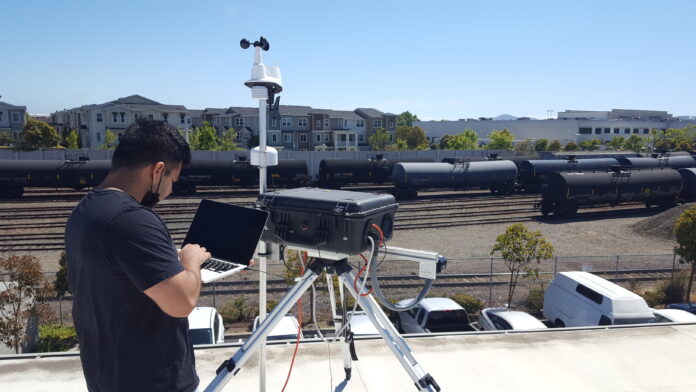Coal trains give off more fine particulate matter than other trains, disproportionately affecting vulnerable populations
By LILLY ACKERMAN — science@theaggie.org
Lea este artículo en español.
A study from researchers at UC Davis’s Air Quality Research Center (AQRC) has quantified the pollution from coal trains running through Richmond, California, a city in the San Francisco Bay Area.
The study is the first to quantify pollution from coal trains in an urban area in the United States. It specifically focused on quantities of fine particulate matter (PM2.5), or particles less than 2.5 microns in diameter.
Richmond is a racially diverse city of about 115,000 residents that is faced with high rates of asthma and heart disease. The study aimed to determine whether Richmond’s coal trains and terminal are a significant source of PM2.5 amid discussion of building a new coal terminal in nearby West Oakland. PM2.5 has already been shown to have negative health effects for those exposed to it.
“Exposure to PM2.5 has been linked to premature mortality, cardiovascular, cerebrovascular, and respiratory diseases, other chronic diseases, adverse birth outcomes, and cognitive and developmental impairments,” the study reads.
The authors needed to measure how much PM2.5 was being released from coal trains versus other types of trains passing through the site being studied, according to Dr. Nicholas Spada, a researcher with the AQCR and co-author on the study. However, he expressed that it was not feasible to manually take the necessary data recordings, since coal train arrival times aren’t publicly available for privacy and security reasons.
To combat this, the researchers set up a camera alongside a small weather station and an air quality sensor. The camera system, programmed with artificial intelligence that Spada developed, would detect trains passing through and trigger the air quality sensor to record measurements from the different types of trains. Full and empty coal trains, freight trains and passenger trains were of interest.
“There was literally nothing in existence that could solve this problem for us, so we created [a solution],” Spada said. “And it worked! We were able to capture these train events and measure the difference in pollution, and it turns out that there is a difference.”
The results were significant when comparing PM2.5 emissions from coal trains to those from freight trains, according to Dr. Bart Ostro, a scientist with the AQRC and the lead author of the study.
“We did find, not surprisingly, increases in PM2.5 [from coal trains passing through] that were greater than the increases that occur from freight trains [passing through],” Ostro said. “With calm winds, we saw very large increases relative to freight trains. It’s pretty convincing.”
Compared to ambient conditions, coal trains added about eight micrograms per cubic meter of PM2.5 to the air. Even coal trains that have been emptied added up to two micrograms per cubic meter. Passenger trains gave off relatively little PM2.5.
This research has important environmental justice implications; coal transport and processing have disproportionate impacts on already economically disadvantaged populations throughout the United States.
“It’s a big issue that nationally, as well as in the Bay Area, these coal trains will typically go through low-income areas,” Ostro said. “These people already tend to have higher rates of asthma and heart disease, so the fact that they have pre-existing morbidity makes them much more susceptible to additional insults [such as pollution from coal trains].”
Ostro also noted that there is no truly “safe” threshold of PM2.5 concentrations for human health. As long as coal is transported and processed, it will consistently pose a health risk.
“Of note, exposure to PM2.5 constitutes an environmental justice concern as exposure and adverse effects are borne disproportionately by the most vulnerable, including infants, children, the elderly, people of color, those with low incomes, and those with underlying health conditions,” the study reads.
Promisingly, Spada’s artificial intelligence can be adapted to detect almost anything that the human eye can see, from oil-refinery flares to automobiles. It can be used for a variety of environmental concerns where it is most needed, from other parts of the Bay Area to locations nationwide that process and transport large amounts of coal, such as Baltimore, Maryland.
“We’re actually moving it to Vallejo, where we’re going to watch some of these other sources that the community is concerned about,” Spada said. “So we can easily adapt it to other situations.”
Written by: Lilly Ackerman — science@theaggie.org




